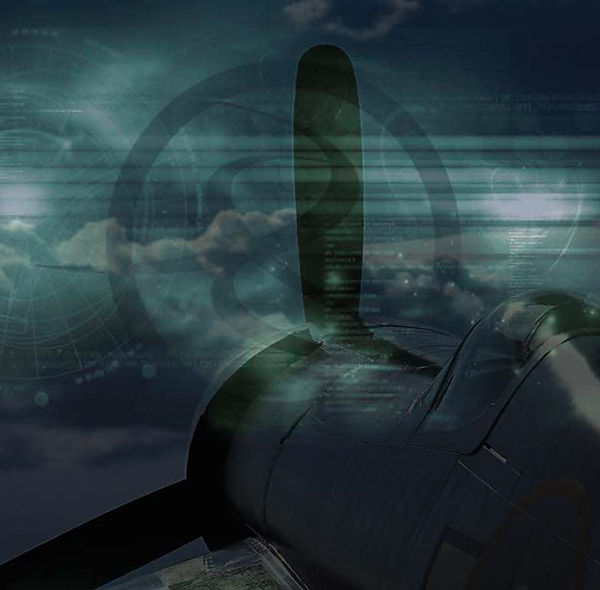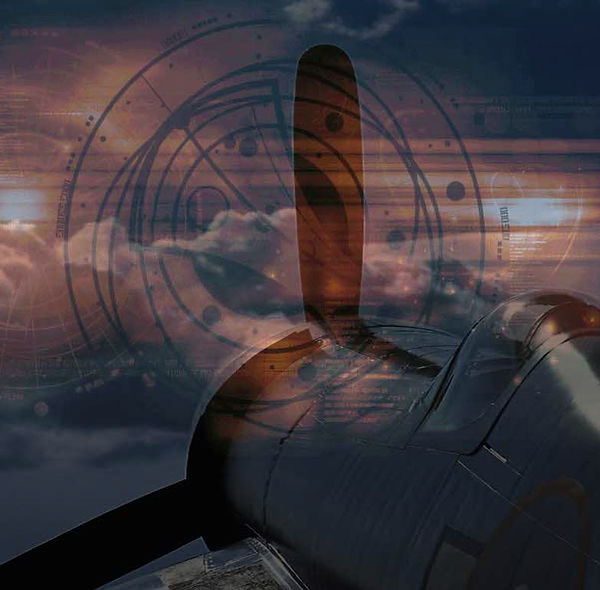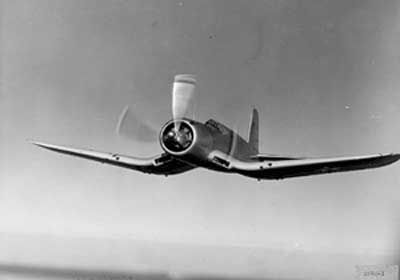
Hold your pointer on a tab in the menu on top of the page to view and handle the sub menus.



In February 1938, the US Navy Bureau of Aeronautics published a requests for proposals (RFP) for both a twin-engine and a single-engine fighter. For the single-engine fighter the Navy requested the maximum obtainable speed, and a stalling speed not higher than 113km/h (70mph). A range of 1610km (1000 miles) was specified. The fighter had to carry four guns, or three with increased ammunition. Provision had to be made for anti-aircraft bombs to be carried in the wing. These small bombs would, according to thinking in the 1930s, be dropped on enemy aircraft formations.
An unusual element of the RFP was that the Navy vowed to consider designs with liquid-cooled engines, in contradiction with a policy settled in 1927 that required air-cooled engines for shipboard aircraft. From the viewpoint of naval aviators, liquid cooling systems had serious disadvantages: They were heavier, more vulnerable, and more difficult to maintain. But in the late 1930s, there was a growing conviction in international aviation circles, that radial engines presented a too high drag penalty. Liquid-cooled engines with their smaller frontal area could be installed in a more streamlined fuselage. Hence the option to accept a fighter built for such an engine, in practice the Allison V-1710.
This engine was indeed chosen by Bell for their entry in the competition: The Bell Model 5 Airabonita, virtually a P-39 Airacobra with tailwheel landing gear, a slightly larger wing, and a stronger structure. As in the P-39, the engine was placed amidships, over the wing. The pilot sat in front of the engine, with a long extension shaft passing between his legs to drive the propeller up front. A 23mm Madsen cannon (or a .50 gun) and two .30 guns were installed in the nose, the cannon firing through the hollow propeller hub.
There was more choice in radial engines: The older Pratt & Whitney R-1830, and the new the Wright R-2600 and Pratt & Whitney R-2800. These air-cooled radial engines had a larger frontal area than the V-1710, and thus generated more drag. For the R-2600 and R-2800 this was compensated for by their power: While the V-1710 was hoped to deliver about 1150hp, the R-2800 was expected to generate 2000hp and more, and the R-2600 1500hp. Radial engines were chosen by Brewster, Grumman, Vought and Curtiss. Grumman proposed a development of the F4F Wildcat, that would be powered by the R-2600 engine. Brewster, manufacturer of the F2A Buffalo that had been the US Navy's first monoplane fighter offered designs with the R-2600 or R-2800. Curtiss proposed developments of the P-36 Mohawk, powered by either the R-2600 or the older R-1830 engine.
In April 1938, Vought proposed its two designs to the US Navy. One, called V-166A by Vought and "Vought A" by the USN, was powered by the R-1830. The other, the V-166B or "Vought B", was designed around the new Pratt& Whitney R-2800 Double Wasp radial engine. This was an 18-cylinder, two-row air-cooled radial. This engine would later also be installed in the competing Grumman F6F Hellcat and in the Republic P-47 Thunderbolt for the USAAF, but the new Vought fighter was the first to use this engine. The R-2800 later acquired a reputation as a powerful and very reliable engine. But it was also very bulky, and aircraft powered by it tended to be big.
In May 1938, the Bureau of Aeronautics evaluated the proposals. The "Vought B" was deemed to be the best one, with a merit figure of 86.4 on a scale from 0 to 100. Hence on 11 June, a contract was given for development of the Vought V-166B, the fighter that would become famous as the F4U Corsair.
The evaluation committee also recommended that the "Brewster A" proposal, rated third best, should be developed because of its alternative R-2600 engine. Because of the management difficulties of Brewster, this never happened. Grumman received a contract to develop to F4F-3 version of the Wildcat, and won the simultaneous competition for a twin-engine fighter with F5F Skyrocket. Their R-2600 engine fighter was rejected, but in June 1941 the Navy would nevertheless order two prototypes of the F6F Hellcat --- which switched to the R-2800 during development. The Navy was also sufficiently intrigued by the Bell proposal to order a prototype, named the XFL-1. But the Bell fighter, ranked sixth of the competitors, was obviously not destined to enter production, and Bell was very reluctant to invest time and money in its development. The history of the Airabonita would be an unhappy one.
In June 1938 the USN signed a contract for a prototype, the XF4U-1, BuNo 1443. After mock-up inspection in February 1939 construction of the XF4U-1 went ahead quickly.
Although the basic lines that would remain with the Corsair through all production variants were unmistakable on the one XF4U-l prototype, it was a unique aircraft with features not found on any other F4U version.
The cockpit was almost three feet further forward in the fuselage, and the entire 273 gallons of internal fuel was carried in four tanks in the wings. Two were in the center wing section, while the other pair was located near the leading edge of the outer wing panels. Aiso located in the wings we re flotation bags that could be deployed in the event of a ditching at sea. The XR-2800-2 engine was originally planned for the XF4U-l, but this was replaced with an XR-2800-4.
A framed canopy was instalIed, but it was different in design than the one which would be used later on production F4U-l s. The windscreen had a telescopic sight fitted initially, but this was later deleted.
The XF4U-1 was painted all silver with the exception of the top of the wings. The top of the wings were painted Chrome Yellow and it wrapped around the leading edge of the wing. The national insignia was placed in accordance of the standards of the time. The only other markings on the aircraft were U.S. NAVY on the fuselage, the BuNo 1443, and the variant designation XF4U-1 on the vertical tail. These markings were in Flat Black.
The XF4U-l had an oval shaped window in the lower fuselage. Early production Corsairs also had a window in this location, but it was rectangular in shape.
Armament consisted of two .30-caliber machine gunsmounted in the cowling with 750 rounds of ammunition for each weapon. A single .50-caliber gun was mounted in each wing, and 300 rounds were provided for each of these guns. Designers also intended for the Corsair to use small 5.2-pound anti-aircraft bombs as part of its armament, and this feature was included on the prototype. In utilizing these weapons, the pilot would fly the fighter above an enemy bomber formation and drop the anti-aircraft fragmentation bombs into it. A total of forty bombs could be carried with four bombs being loaded into each of ten compartments in the outer wing sections. A teardrop shaped bomb aiming window was located in the lower fuselage beneath the cockpit so that the pilot could line up his targets before releasing the bombs,this feature necessitated the floorless cockpit.
First flight of the XF4U-1 was made on 29 May 1940, by Lyman A. Bullard Jr. The XF4U-1 was powered by a XR-2800-4 engine, rated at 1805hp. The first flight was not uneventful. A hurried landing was made when the elevator trim tabs failed because of flutter.
Early testing encountered a serious setback when project pilot Boone T. Guyton ran out of fuel during the fifth test flight and made an emergency landing on a golf course. The XF4U-1 was badly damaged, but not beyond repair, and Chance Vought rebuilt it.
On 1 October the XF4U-1 made a flight for Stratford to Hartford with an average ground speed of 650km/h (404mph). It was then the first US fighter to fly faster than 400mph. The XF4U-1 also had an excellent rate of climb. On the other hand, the testing of the XF4U-1 revealed that some of the requirements of the US Navy would have to be rewritten. In full-power dive tests speeds of up to 885km/h were achieved, but not without damage to the control surfaces and access panels, and in one case, an engine failure. The spin recovery standards also had to be relaxed, as recovery from the required ten-turn spin proved impossible without recourse to an anti-spin chute.
Much time was spent trying to improve the handling of the XF4U-1. Numerous changes were made to the ailerons, with success, as these were later known to be very effective. However, the low-speed handling characteristics left much to be desired. The F4U had a troubling tendency to drop a wing when it stalled. And this was a critical factor for a shipboard fighter, which would have to make dangerous deck landings.
After crashing during its fifth test flight, the prototype was rebuilt and fitted with a propeller of slightly different design. It had an empty weight of 7 ,418 pounds and a gross weight of 9,375 pounds. Rate of climb was 2,600 feet per minute, and the service ceiling was 35,500 feet. On October 1, 1940, it made history when it became the first U. S. fighter to exceed 400 miles per hour in level flight, and its maximum speed was rated at 405 miles per hour. Range was 1 ,070 statute miles. In almost every case, these performance figures were in excess of what was expected.
Variations of the XF4U-1
Engine mounted farther back differs from Production Model
.30 cal. (7.62mm) M2 machine guns
Larger windscreen
Short tail
XR-2800-4 engine
2 compartments for five 5.21 -lb ( 2.37 kg) bombs in each wing
Small tail gear differs from Production Model
Tailhook system
Belly bomb aiming window
Clustered exhaust pipes
Description
Manufacturer:Vought
Base model:F4U
Designation:XF4U
Version:-1
Name:Corsair
Service: -
Basic role:Fighter
Designation Period:1922-1962
Status:Prototype
(*) : Index - References - Notes - Citations
XF4U-1 Corsair (*)



Credits to NACA , US National Archives, US NAVY, USMC, Vought